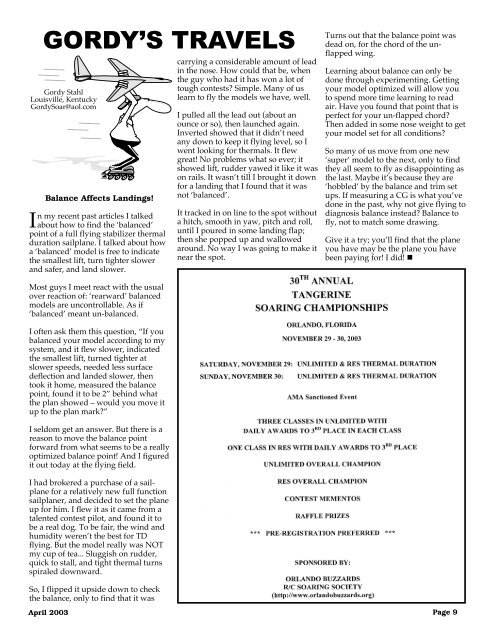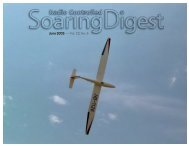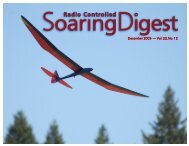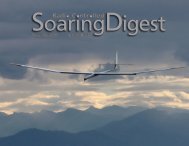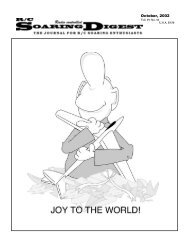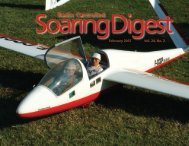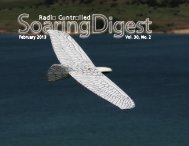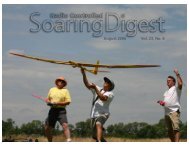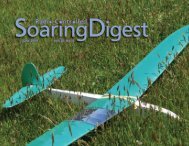4/03 RCSD - RC Soaring Digest - Rcsoaring.com
4/03 RCSD - RC Soaring Digest - Rcsoaring.com
4/03 RCSD - RC Soaring Digest - Rcsoaring.com
Create successful ePaper yourself
Turn your PDF publications into a flip-book with our unique Google optimized e-Paper software.
GORDY’S TRAVELS<br />
Gordy Stahl<br />
Louisville, Kentucky<br />
GordySoar@aol.<strong>com</strong><br />
Balance Affects Landings!<br />
In my recent past articles I talked<br />
about how to find the ‘balanced’<br />
point of a full flying stabilizer thermal<br />
duration sailplane. I talked about how<br />
a ‘balanced’ model is free to indicate<br />
the smallest lift, turn tighter slower<br />
and safer, and land slower.<br />
carrying a considerable amount of lead<br />
in the nose. How could that be, when<br />
the guy who had it has won a lot of<br />
tough contests? Simple. Many of us<br />
learn to fly the models we have, well.<br />
I pulled all the lead out (about an<br />
ounce or so), then launched again.<br />
Inverted showed that it didn’t need<br />
any down to keep it flying level, so I<br />
went looking for thermals. It flew<br />
great! No problems what so ever; it<br />
showed lift, rudder yawed it like it was<br />
on rails. It wasn’t till I brought it down<br />
for a landing that I found that it was<br />
not ‘balanced’.<br />
It tracked in on line to the spot without<br />
a hitch, smooth in yaw, pitch and roll,<br />
until I poured in some landing flap;<br />
then she popped up and wallowed<br />
around. No way I was going to make it<br />
near the spot.<br />
Turns out that the balance point was<br />
dead on, for the chord of the unflapped<br />
wing.<br />
Learning about balance can only be<br />
done through experimenting. Getting<br />
your model optimized will allow you<br />
to spend more time learning to read<br />
air. Have you found that point that is<br />
perfect for your un-flapped chord?<br />
Then added in some nose weight to get<br />
your model set for all conditions?<br />
So many of us move from one new<br />
‘super’ model to the next, only to find<br />
they all seem to fly as disappointing as<br />
the last. Maybe it’s because they are<br />
‘hobbled’ by the balance and trim set<br />
ups. If measuring a CG is what you’ve<br />
done in the past, why not give flying to<br />
diagnosis balance instead? Balance to<br />
fly, not to match some drawing.<br />
Give it a try; you’ll find that the plane<br />
you have may be the plane you have<br />
been paying for! I did! <br />
Most guys I meet react with the usual<br />
over reaction of: ‘rearward’ balanced<br />
models are uncontrollable. As if<br />
‘balanced’ meant un-balanced.<br />
I often ask them this question, “If you<br />
balanced your model according to my<br />
system, and it flew slower, indicated<br />
the smallest lift, turned tighter at<br />
slower speeds, needed less surface<br />
deflection and landed slower, then<br />
took it home, measured the balance<br />
point, found it to be 2” behind what<br />
the plan showed – would you move it<br />
up to the plan mark?”<br />
I seldom get an answer. But there is a<br />
reason to move the balance point<br />
forward from what seems to be a really<br />
optimized balance point! And I figured<br />
it out today at the flying field.<br />
I had brokered a purchase of a sailplane<br />
for a relatively new full function<br />
sailplaner, and decided to set the plane<br />
up for him. I flew it as it came from a<br />
talented contest pilot, and found it to<br />
be a real dog. To be fair, the wind and<br />
humidity weren’t the best for TD<br />
flying. But the model really was NOT<br />
my cup of tea... Sluggish on rudder,<br />
quick to stall, and tight thermal turns<br />
spiraled downward.<br />
So, I flipped it upside down to check<br />
the balance, only to find that it was<br />
April 20<strong>03</strong><br />
Page 9


